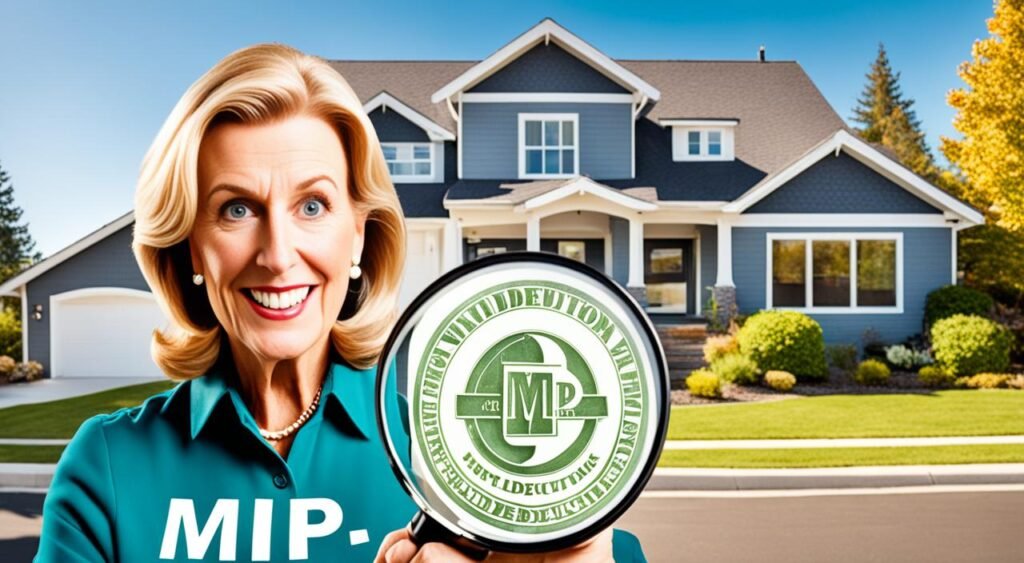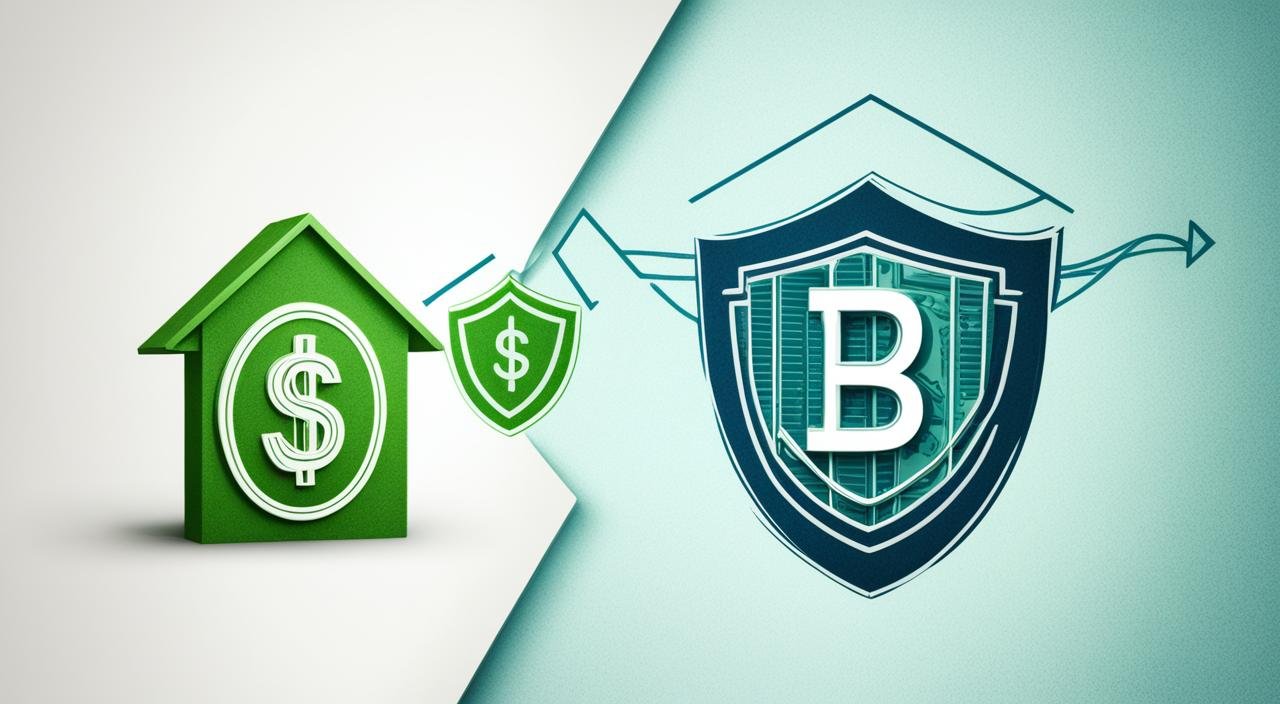Mortgage insurance premium, or MIP, is needed for homebuyers with FHA-backed loans. It’s a way for lenders to protect themselves from borrowers who might not pay back their loans. Unlike loans that don’t need insurance unless the down payment is low, FHA loans always require insurance.
Key Takeaways
- Mortgage insurance premium (MIP) is a type of mortgage insurance required for FHA-backed loans.
- MIP helps protect lenders against higher-risk borrowers who may default on their loans.
- FHA mortgages require all borrowers to have mortgage insurance, unlike conventional loans which only require PMI for down payments less than 20%.
- MIP costs are typically included in the monthly mortgage payment.
- Borrowers may be able to cancel or remove MIP under certain circumstances.
Introduction to Mortgage Insurance Premium
Mortgage insurance premium (MIP) is key for those buying a home, especially with FHA or conventional loans and less than 20% down. It’s important to know what MIP is and why it’s needed. This knowledge helps buyers understand mortgage financing better.
What is a Mortgage Insurance Premium?
A mortgage insurance premium is a fee paid by the borrower to an insurance company. This could be the Federal Housing Administration (FHA) or a private mortgage insurance (PMI) provider. The insurance covers the lender if the borrower can’t pay back the mortgage loan. FHA loans always need MIP because they help borrowers with lower credit scores or smaller down payments.
Why is Mortgage Insurance Premium Required?
The main reason for MIP is to lower the lender’s risk. It makes getting a mortgage easier for people who don’t have 20% for a down payment. By sharing the risk, lenders are more likely to approve loans for those with lower credit scores or smaller down payments.
This also lets the FHA and private insurers offer loans with better terms. These include lower interest rates and easier credit checks for more people.
| Mortgage Type | Mortgage Insurance Premium Required? |
|---|---|
| FHA Loan | Yes, always required |
| Conventional Loan | Only if down payment is less than 20% |
It’s crucial for homebuyers to understand the mortgage insurance premium. This knowledge helps them in the mortgage market and helps them reach their homeownership goals.
Types of Mortgage Insurance Premium

When looking into mortgage financing, you’ll come across different types of mortgage insurance premiums (MIPs). These include private mortgage insurance (PMI), FHA mortgage insurance premium, and USDA mortgage insurance premium. It’s important for homebuyers to know the differences to make smart choices.
Private Mortgage Insurance (PMI)
Private mortgage insurance is needed for conventional loans with less than 20% down payment. The cost of PMI depends on the down payment and credit score. It helps lenders take less risk, allowing buyers to get a home with a smaller down payment.
FHA Mortgage Insurance Premium
FHA loans require an FHA mortgage insurance premium with upfront and monthly costs. This MIP protects the FHA if a borrower defaults. FHA loans are great for first-time buyers and those with lower incomes because they have easier credit and down payment rules.
USDA Mortgage Insurance Premium
The USDA mortgage insurance premium is like FHA MIP, with upfront and monthly costs. It’s for loans backed by the U.S. Department of Agriculture. These loans help people buy homes in rural and suburban areas.
“Understanding the different types of mortgage insurance premiums can help homebuyers navigate the complexities of financing and make the best decision for their unique financial situation.”
mortgage insurance premium Costs and Calculation

FHA loans have two main parts to their mortgage insurance premium (MIP): upfront and annual. It’s important for homebuyers to know these costs to plan their budgets well.
Upfront Mortgage Insurance Premium
The upfront MIP for an FHA loan is 1.75% of the loan’s total. You can pay this fee when you close on the house or add it to your loan. This makes your monthly payments higher.
Annual Mortgage Insurance Premium
The annual MIP for FHA loans is usually between 0.15% and 0.75% of the loan amount. This is split into a monthly payment. The exact amount depends on the loan size, how much you owe compared to the home’s value, and the loan’s length.
Let’s say you get an FHA loan of $300,000 with a 95% loan-to-value ratio. You might pay an annual MIP of 0.70%, or $175 monthly. This will be part of your regular mortgage payment.
Knowing about the upfront mortgage insurance premium and annual mortgage insurance premium helps FHA loan borrowers plan their monthly costs better.
Factors Affecting Mortgage Insurance Premium Rates

Several key factors influence the cost of mortgage insurance premium. Knowing these can help borrowers make better choices and lower their mortgage insurance premium rates.
The loan amount is a big factor in mortgage insurance premium rates. Bigger loans usually mean higher annual premiums. This is because the risk for the lender or insurer goes up with a larger loan amount.
The loan-to-value (LTV) ratio is also important. Loans with smaller down payments (and higher LTV ratios) have higher annual premiums. This is because there’s more risk for borrowers who don’t have much equity in their homes.
The mortgage term affects mortgage insurance premium rates too. Longer loans often mean higher annual premiums. This is because the risk is spread out over a longer time.
Lastly, a borrower’s credit score and down payment size matter for mortgage insurance premium rates. Those with lower credit scores or smaller down payments might pay more in annual premiums.
Understanding these factors helps borrowers make smarter choices about their mortgage insurance premium. They can find ways to lower their rates.
VA Loans and Funding Fees

For borrowers looking into VA-backed loans, there’s a special fee to consider – the VA funding fee. Unlike regular mortgages, VA loans don’t need monthly insurance payments. Instead, borrowers pay an upfront “funding fee” that changes based on things like military service, down payment size, and if it’s their first VA loan.
This fee can be added to the loan, making it easier for homebuyers. The fee rates are between 1.4% to 3.6% of the loan’s total. For instance, first-time VA loan users with no down payment face a fee of 2.3% to 3.6%. But, if they put down at least 5%, the fee drops to 1.4% to 3.6%.
| Loan Type | Funding Fee Percentage |
|---|---|
| First-time VA Loan, No Down Payment | 2.3% – 3.6% |
| Subsequent VA Loan, No Down Payment | 3.6% |
| First-time VA Loan, 5% or More Down | 1.4% – 2.3% |
| Subsequent VA Loan, 5% or More Down | 1.4% – 3.6% |
Unlike FHA and USDA loans, the VA funding fee doesn’t need a monthly payment. This makes VA loans a good choice for eligible borrowers, especially those with little money for a down payment.
Understanding the VA funding fee and how it’s different from regular mortgage insurance helps homebuyers make better choices when looking at VA loan options.
Canceling or Removing Mortgage Insurance Premium
Homeowners might be able to cancel or remove their mortgage insurance premium (MIP) based on their loan type. The rules for canceling or removing MIP differ between conventional loans with private mortgage insurance (PMI) and government-insured loans like FHA loans.
Requirements for Canceling PMI
For conventional loans with PMI, you can cancel it once you’ve built up 20% equity in your home. This happens when your home’s value goes up and you pay down the mortgage. To cancel PMI, you must meet certain loan-to-value ratio levels and show your lender the needed documents.
Requirements for Removing FHA MIP
The rules for removing FHA MIP are unique. If you got your FHA loan before June 2013, you might cancel MIP once you’ve paid off 78% of the original loan-to-value ratio. But, if you got your FHA loan after June 2013, you might have to pay MIP for the loan’s life. You can avoid this by refinancing into a non-FHA mortgage.
It’s important for homeowners to know the rules for canceling PMI or removing FHA MIP. This knowledge lets you plan well and save money over time.
Piggyback Loans as an Alternative
Some lenders offer a “piggyback” second mortgage instead of mortgage insurance. This lets borrowers avoid paying private mortgage insurance (PMI). They do this by taking a smaller primary mortgage and a second loan for the down payment.
But, it’s important to look at the total cost to see if it’s cheaper than PMI. Piggyback loans, or second mortgages, have their own costs and benefits. You need to think about these when deciding if they’re right for you.
Advantages of Piggyback Loans
- Can help avoid PMI and mortgage insurance payments
- May provide a lower overall interest rate compared to PMI
- Allows for a lower down payment on the primary mortgage
Potential Drawbacks of Piggyback Loans
- Higher total borrowing costs due to two separate loans
- Potentially higher interest rates on the second mortgage
- Increased risk of foreclosure if unable to make payments on both loans
Whether a piggyback loan or second mortgage is better than paying PMI depends on your finances and goals. You should compare the costs and benefits carefully before making a choice.
| Metric | Piggyback Loan | Mortgage Insurance |
|---|---|---|
| Upfront Cost | Higher due to second loan | Lower or no upfront cost |
| Monthly Payments | May be higher due to two loans | Included in monthly mortgage payment |
| Long-Term Costs | Potentially higher due to interest on two loans | Determined by loan term and PMI cancelation requirements |
| Risk of Foreclosure | Higher due to two loans | Lower risk if PMI is eventually removed |
Tax Implications of Mortgage Insurance Premium

Recent years have brought changes to the tax rules for mortgage insurance premium (MIP) or private mortgage insurance (PMI). Until 2017, homeowners could deduct mortgage insurance premiums on their taxes. This deduction was then brought back for 2018-2020 before ending again.
Homeowners who paid MIP or PMI from 2018-2020 might still deduct it. They can do this by itemizing their taxes. Lenders must report the mortgage insurance premiums paid on Form 1098. Homeowners can use this form when filing taxes to claim the mortgage insurance premium tax deduction.
The itemized deductions, including the mortgage insurance premium tax deduction, have limits based on income. Homeowners should talk to a tax expert to see if they qualify for this deduction.
“The deduction for mortgage insurance premiums has been a valuable tax benefit for many homeowners, particularly those with lower down payments and higher loan-to-value ratios.”
The mortgage insurance premium tax deduction is no longer available. But, homeowners with MIP or PMI should keep up with tax laws. This helps them save on taxes and follow the rules.
Getting Help with Mortgage Payments

If you’re having trouble making your mortgage payment, there’s help out there. The Consumer Financial Protection Bureau (CFPB) has a tool to find HUD-approved housing counseling agencies near you. These agencies offer mortgage payment assistance and advice to prevent foreclosure.
The HOPE Hotline is also there for you, available 24/7. It offers free, private help. The hotline connects you with local resources and helps you find ways to manage your mortgage payments.
- Use the CFPB’s Find a Counselor tool to find HUD-approved housing counseling agencies
- Call the HOPE Hotline at 1-888-995-HOPE for free, private help 24/7
- Look into options to avoid foreclosure and get your mortgage payments back on track
If you’re finding it hard to make your mortgage payment, don’t hesitate to ask for help. These resources can offer the support and advice you need to get back on your feet and keep your home.
Comparing Mortgage Insurance Options
When looking at mortgages, it’s key to compare different loan options and their mortgage insurance needs. Each type, like FHA, conventional, USDA, and VA loans, has its own mortgage insurance rules. These rules can greatly affect the cost of buying a home.
FHA loans need Mortgage Insurance Premium (MIP), which is a monthly fee added to your mortgage. Conventional loans might require Private Mortgage Insurance (PMI), which you can stop paying once your home’s value goes up. USDA loans have their insurance, and VA loans have an upfront fee but no monthly insurance.
Looking at the total cost of each option, including mortgage insurance, helps you pick the best loan for your finances. Knowing the differences between these options lets you make a choice that fits your financial goals and budget.
| Loan Type | Mortgage Insurance | Cost |
|---|---|---|
| FHA Loan | Mortgage Insurance Premium (MIP) | Upfront and Annual Premiums |
| Conventional Loan | Private Mortgage Insurance (PMI) | Monthly Premiums |
| USDA Loan | USDA Guarantee Fee | Upfront and Annual Premiums |
| VA Loan | Funding Fee | Upfront Fee |
By thinking about the mortgage insurance needs and costs of each loan, you can make a choice that fits your financial goals and plans.
Also Read: What Is A Mortgage Term And How Does It Impact Monthly Payments?
Conclusion
Mortgage insurance premiums are key in the home loan process. It’s important to know about private mortgage insurance (PMI) and government-backed options like FHA and USDA. Your credit score, down payment, and loan-to-value ratio affect the cost of these premiums.
This can greatly change your mortgage costs. Knowing how to cancel or remove mortgage insurance can save you money. Exploring options like piggyback loans can also help you save.
Understanding the tax implications and getting help with mortgage payments is also crucial. This knowledge can improve your grasp of home financing.
Being well-informed about mortgage insurance lets you confidently navigate the home buying process. It helps you find a loan that fits your financial situation. Whether you’re buying your first home or have done it before, knowing about mortgage insurance is key. It helps you make better decisions and reach your homeownership goals.
FAQs
Q: What is Mortgage Insurance Premium?
A: Mortgage insurance premium is a type of insurance policy that protects the mortgage lender in case the borrower defaults on the loan. It is typically required for loans where the borrower makes a down payment of less than 20% of the home’s value.
Q: How is Mortgage Insurance Calculated?
A: Mortgage insurance premiums are calculated based on factors such as the loan amount, the loan-to-value ratio, and the term of the loan. The premium can be paid upfront or added to the monthly mortgage payments.
Q: What is an FHA Loan and How Does it Relate to Mortgage Insurance?
A: An FHA loan is a mortgage loan insured by the Federal Housing Administration. FHA loans require borrowers to pay mortgage insurance premiums, both upfront and annually, regardless of the down payment amount.
Q: How Can I Get Rid of Mortgage Insurance?
A: To get rid of mortgage insurance, you can refinance your loan to a conventional mortgage once you have sufficient equity in your home, typically 20% or more.
Q: What are the Costs Associated with Mortgage Insurance?
A: Mortgage insurance costs can include an upfront premium, which is usually a percentage of the loan amount, as well as an annual premium that is added to your monthly mortgage payments.
Q: Can I Avoid Private Mortgage Insurance (PMI)?
A: You can avoid PMI by making a down payment of 20% or more when purchasing a home. This will eliminate the need for mortgage insurance.
Q: What Happens if I Stop Paying Mortgage Insurance Premiums?
A: If you stop paying mortgage insurance premiums, you risk defaulting on your loan and potentially facing foreclosure. It’s important to continue making these payments as required by your mortgage lender.





